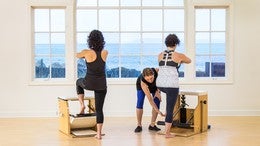Description
About This Video
Transcript
Read Full Transcript
Hi everyone. I'm Amy Taylor, outbursts from the Pilati Center in Boulder, Colorado. And I'm here with the wonderful Jen and we're going to do a brief tutorial on how you use your feet really, really effectively in [inaudible]. And we're going to start on the pedal pole because it's an awesome way to learn this skill. But then I'm going to teach a math class at a chair class and a reformer class, and we're gonna thread this theme throughout. And I have found just probably for the last two or three years maybe I've been heading in this direction, getting clearer and clearer and clearer around what the feet should do, how the feet work best, and how they support the whole body and free it literally.
And one of the most fabulous parts of the freeing for anyone who's struggling with swan in particular, extension in particular, it's really one of the great answers to enabling the spine to free up so you can do extension more effectively. So we'll look at that as well. Okay, so we're just, we're not going to do all the pedophile exercises. We're really just going to work, work on this one exercise where you're standing in the half-point or the Relevate, um, and doing the small pleaser knee bends so that we can just look at the feet. Okay. So gentlemen, put her back on the pole. Rise up on your toes. Great. And you, maybe you won't be so much necessarily in pillow. ATSB might be a little wider on this one. You're going to take your handles.
Okay. So the handles are for stability, balance, and really though connection. So we'll see that as we, as we move through that you actually want that nice connection in your hands because it helps quite a bit. All right, so we have the heels together on the pole. I'm going to have you come in a little closer so you're bit higher. Yep. And then maybe a slight little bit more turnout. Yeah. Right. And then I'm going to say this word that I used, the prayer foot concept, which means that you would take a little bit more of the souls of your feet towards one another. Yeah. So that you're really standing on the metatarsal.
All right. So we want to be able to see this beautiful arch right here and that doesn't change. And then we want to keep the weight distributed across the metatarsal arch too. She's doing that very beautifully so that she keeps weight on her little toes as well. All right. And what we're going to find out is that not only is this awesome for just enabling a lot of the exercises and particularly extension, but it changes the entire relationship of the need of the hip to the abdominals, to the spine, to the shoulders and on through. So we'll watch that as well.
So from this point you're gonna take your arms out to your side, have a little, and this is a challenging piece in [inaudible] as well. Um, you're actually gonna have the elbow up and the hand down. All right? So when you press the pedal pole spring, you actually press with the palm and not with, can you show the other one where you might lock the elbow down and press with the arm? All right, so in plays, there's always this lightness in the elbow, even a little lighter. Yeah. So the hand is what pushes the spring, which is what really gives you the lift, right? So the lift is starting from the arch of the foot here and the arch of the foot here. And then we're going to basically ankle flex. So she's going to bend the hip knee, but really the ankle and it's good to focus on that. So you're going to start to ple a just bend. Good. Now as we come down, you're gonna make sure you're standing on the little toe. Now stay for one sec.
No weight in my hand, right? So the weight, the quad is still pulling up like this and the weight of the body has to fall to the tailless and then into the tripod of the foot, right? So the knees actually pulling up and the Shin is coming forward. And that's why ankle fluxion is a good thing to stay as opposed to knee flection or even hip flection. So we're thinking about this relationship here so that when she starts back up again, she starts with the arch of the foot, the ankle, and then we might not go all the way to that because we actually want it to go up instead of for instance back. Okay, so we're trying to streamline this whole line all the way up, all the way up and write out to the hands and out through the top of the head. Okay, so she's going to bend again and you can see on the angle here that you want to see that the knee is coming right over maybe the second toe, but the weight is in the foot and not the knee.
And then you press into the palms through the arches and rise up again. Okay? So let's do a couple of those. So you bend and left what you can be a little more prayer foot on. There you go. You're going to find that it gives you that deep wrap in the hip, the knee out, just a little bit. No weight here. Yes. Right? So the feet hold the weight and the legs are free.
And you arise back up again. Great therapeutic exercise for anybody who's struggling with knee issues and also um, strengthens the feet like crazy. So just a couple more. So you're pressing on the handle, even a little lighter in your elbows. Yes. And then the feet arches little bit wider. And then last time you go down and knees a little wider. So it's a little down.
Maybe go out a bit more with your knees and a little lighter here. So you're pressing into it. There you go. And then exhale, come right back up again. Better, better, better, better. Yes you can, you can. So they're forced to ability and balanced, but they're also, and the connection, but they are also strengthening. You've got a bit too, so depends on springs and your height, et cetera. With people. You can also, if people have delicate feet, put a black pad down there for a little bit more cushion under the toes for this particular exercise.
And then of course this one gets crazier and it goes to one leg once. Try. Okay. So you do shift the standing foot under you just a little bit. So whichever leg you're going to pick up, just shift that foot a little. But this stays the same. And then this leg exactly can come out into an attitude in the front. Uh, you can bend this knee and just kind of pick the whole thing up.
So here's what we're talking about. Now. Feel that arch. Yes. And then hold this one up to right and then feel these palms. Yes. So your four foot animal again? Yeah. And then you bend your ankle more your ankle than your knee. Oh go you and then come back up. Yeah. So starting a little smaller.
We'll try it again, but hopefully you could see, cause it's very subtle, but I could see very quickly that she has to stand on the sweat more effectively. Less standing here, more standing here. And then you flex here, like actually flex your ankle instead of your knee. And then imagine you're holding a ball or something with that foot and your poems. Yes. So you're suspended in the four footedness of your kind of original primal design and keep that art. Keep that arc. Yes. So this arch in particular is doing so much work, not just to be strong, but to kind of deal with all of the balance issues that are needed. Yeah.
I want to try the other foot very often. Incredibly asymmetrical when we get this minute and detailed about things. Yeah. Right. So these are for all that. And again, it's just the palm play with that and see the difference. We're gonna work with that in all the other exercises as well. So the weight is here and then the weight is there. Yeah.
If you could push on that a little bit more. Yes. Good. And now this knee could be a little wider. So this one is just a little bit more challenging that way. Yes. And you hold your arches on your palms instead of your elbows or your tight underarms. Tight lats.
So sometimes before you take your foot off that piece of paper, it's kind of good to sort of note where those are. And you'll see that here's our standing arts for this exercise and then the heel, and then you have that triangle at all times. And you can sort of imagine a little bit of a parachute or a sale inside that triangle and maintaining the suspension of that arch. We'll feel it a little bit in our palms too, so that even in hundred you're not kind of leaning on your arms, you're actually standing in your hand in long stretch and so many of the exercises, it makes such a big difference. And then you start to be incredibly aware of exactly where your feet are the whole time and how much they play a role in maintaining the whole body suspension, the whole body organization, the whole body balance and connection.
So we're going to show just a quick swan for an example on the reformer. So now we're going to show this concept in Swan, which I think is one of the places where people really, really struggle with this exercise and trying to figure out what's the answer, where, where am I find something of security that I could use to feel like I get this exercise and I don't constantly just kind of keep trying to not hurt this or not go there or not overuse that or where are my heels in space, all that kind of thing. And then I want to report just a couple of things that Jen was saying afterwards when she did that. A couple of things right off the bat was that she said the knees disappear, which I think is awesome and that's exactly what you'll feel. And that's why it's such a great knee rehab exercise because we have such a struggle with the knee nowadays being kind of in front of the Tibia a little bit. And then when we bend, we're just let weight go right into the knee and the knee obviously doesn't like that.
So getting the arch of the foot to hold the Tibia forward and then maintaining the suspension of the quad up into the belly up into the, so as is a huge piece of getting the knee stronger again. And then she also said that it kind of put her in a kind of external rotation, which remodel would call the wrap a little bit. It's not officially externally rotated, but it does cause this spiral up into the hip, which then frees your hip. Right. And that's a piece of maybe what helps quite a bit in the swan as well, is that you don't get stuck in here trying to figure out what do I do right here? Because you're not here, you're actually on your feet instead. And that's kind of just enables the whole thing to be freer.
So taking the Pedo Pole idea, the arches of the feet, the pole that the heels stay on, right? So that the feet stay, nothing changes there. You imagine that pole where your heels were and you imagine the big toe, little toe ball, the foot, very strong triangle there and from that point on then everything else is actually free to go any which way you want to take it. Whether you're going into extension, fluxion side, bending rotation, it really doesn't matter because it's a centralized place and you want to make sure, for instance, when we get into footwork or something that basically footwork is just the same idea taken into a different horizontal plane. All right, but we're just going to look at Swan and see if we can make it make sense. One of the things that happens is you don't have the pole on your heel anymore, right? So now you're like where are my heels in space?
So part of what you want to learn in the pedal pole exercise itself is that sense of awareness of the heels staying together, staying on the pole and staying as you move back and forth through the flection of all your other joints so that you start to get this sense that it's not an exterior force that's doing it so much as the arches of your feet doing it. So for some people in Gen kind of did this pretty naturally, but for some people when you get them in the right position on the Pedal Pole, you actually have to then say, you know, inchworm up your arches or burnt on a perch, your feet or something. So they actually really activate the arch and don't just kind of stand on it, right? So the activation of the art is really key. And then really key here. So you'll find, because your heels aren't on anything in footwork, they're not on anything and stomach massage, they're not on anything in Swan, you know that you want, you really want to play with the idea of memorizing that feeling so you can do it. So that even when you're doing it on the ladder barrel, you're not using the rung of the ladder above the ball of your feet as a guide. You're standing on the balls of your feet and arches and just knowing where your heels are in space so that it'll transfer over here very readily.
Okay? So sometimes we'll teach it on the wood. I think on a [inaudible] machine you can go right away to the foot bar because of the proportions, which is nice. So if you are willing to go on the foot bar, I'll give you a little support. The main thing is that how do you just recreate what we did on the pedal pole? Okay, so push out a little bit. You're on the nice kind of meaty part of your quad here.
And then come down a little lower and then pretend the petty pole. So lift your heels a little bit more. So you will be pushing out, but you're not going to go into a forced arch. Can you show that where you just fall? Right, so that she's standing here. Now we want to be standing in the arch and I say to people, have an ankle. Always have an ankle, right? So she's actually in a little bit of ankle flection, but she has that nice arch here. And even if the little toe isn't on anything, you're still imagining it on something.
So you have this perfect little tripod right here. And then take your hands in the well above head and let's link your thumbs. So just hook them together. There you go. All right, so now this is really where you just keep your eyes. This doesn't change. She feels the stability of this, the power, the organization, the connection to lift her thumbs in her belly to rise up. So she just stays right here, here, here, here, here.
That's the way. And then you can bend your back as far as you can bend, but you don't change this and then you can round back over again. All right, so now I'll come and help you at the other end. But You keep this and trust this, this on a more anatomical level, we're really working the posterior tibialis muscle that comes from the arch of the foot through the inner ankle, bone up the back of the Tibia and facially basically becomes your so as and your diaphragm. So that has a really clear organization to it. So from inner arch of the foot up the back of the Tibia to the so as to the diaphragm so that we could release the spine a little bit. Okay, so you take your thumbs up, you keep your feet and you left and you bend right. And let it go. Take your hands behind you off of me. That's the way.
There we go. And then you come back down again. Okay. So one more time. Keep your arches and pretend you have a ball in your hand and you're gonna throw it behind you. But keep your arches and throw the ball. Just throw it. That's the way Gen. And then come back down. Let's do the whole thing. So you're going to go inhale up arch, way back. Good. Open the arms, chest to the box.
And then our two Gan really big way back and see if you could lift all 10 toes. So you know you're on the arches. Beautiful. Less neck, more belly, and stretch out and round over, right? So play with that a little bit yourself. The goal being that you trust this so much that everything else is freer and you don't have to hold. You don't have to fear, you don't have to protect, you don't have to anticipate. You can really just trust that this is your security and it's gonna be the thing that organizes you so beautifully that you can just extend and come back again.
All right, so try that out and let me know how it goes.
Comments
Joanne, the video should play well for you. There are a few reasons your audio could be out of sync. If restarting your computer and closing programs that you're not using doesn't solve the problem, please send us an email and we'll do our best to help you through. The information in Amy's tutorial is too good to be distracted by what are usually simple solutions to audio being out of sync. Thank you for letting us know how you experienced this tutorial so far. support@pilatesanytime.com
You need to be a subscriber to post a comment.
Please Log In or Create an Account to start your free trial.


























